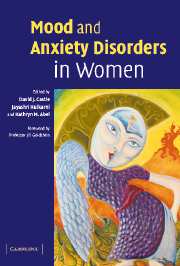Book contents
- Frontmatter
- Contents
- Contributors
- Preface
- Foreword
- 1 Pubertal development and the emergence of the gender gap in mood disorders: A developmental and evolutionary synthesis
- 2 Borderline personality disorder: Sex differences
- 3 Substance use and abuse in women
- 4 Anxiety disorders in women
- 5 Posttraumatic stress disorder in women
- 6 Domestic violence and its impact on mood disorder in women: Implications for mental health workers
- 7 Depression in women: Hormonal influences
- 8 Anxiety and mood disorders in pregnancy and the postpartum period
- 9 Pharmacological treatment of anxiety and depression in pregnancy and lactation
- 10 Bipolar affective disorder: Special issues for women
- 11 Mood and menopause
- 12 Anxiety and depression in women in old age
- Index
8 - Anxiety and mood disorders in pregnancy and the postpartum period
Published online by Cambridge University Press: 13 August 2009
- Frontmatter
- Contents
- Contributors
- Preface
- Foreword
- 1 Pubertal development and the emergence of the gender gap in mood disorders: A developmental and evolutionary synthesis
- 2 Borderline personality disorder: Sex differences
- 3 Substance use and abuse in women
- 4 Anxiety disorders in women
- 5 Posttraumatic stress disorder in women
- 6 Domestic violence and its impact on mood disorder in women: Implications for mental health workers
- 7 Depression in women: Hormonal influences
- 8 Anxiety and mood disorders in pregnancy and the postpartum period
- 9 Pharmacological treatment of anxiety and depression in pregnancy and lactation
- 10 Bipolar affective disorder: Special issues for women
- 11 Mood and menopause
- 12 Anxiety and depression in women in old age
- Index
Summary
Mental illness either in pregnancy or postpartum has significant and potentially serious long-term deleterious outcomes, not just for the woman but also for her entire family, and in particular, for her infant.
The immediate effects of depression, anxiety and stress during pregnancy include an increase in the rate of pre-term delivery, lower APGAR scores, lower birth weights and smaller head circumference (Dayan et al., 2002; Hedegaard et al., 1996; Lou et al., 1994; Orr & Miller, 1995; Orr et al., 2002; Steer et al., 1992; Wichers et al., 2002). It is as yet unclear whether these effects are related directly to physiological changes occurring in the depressed mother, in particular those associated with stress responses along the hypothalamic-pituitary-adrenal axis (Dieter et al., 2001; Gitau et al., 2001; Lockwood, 1999; Sandman et al., 1997; Weinstock, 1997); or indirectly as a result of poor health behaviours (Lindgren, 2001; Zuckerman et al., 1989).
The long-term adverse effects of prenatal depression, anxiety and stress on the offspring have been known for some time and are well documented. For example, newborns of depressed mothers consistently show behavioural differences and developmental problems when compared to infants born to non-depressed mothers (Grace et al., 2003; Jones et al., 1998; Lundy & Field, 1996; Lundy et al., 1999; Martins & Gasffan, 2000; Weinberg & Tronick, 1998).
Keywords
- Type
- Chapter
- Information
- Mood and Anxiety Disorders in Women , pp. 136 - 162Publisher: Cambridge University PressPrint publication year: 2006
- 3
- Cited by

